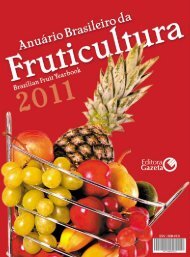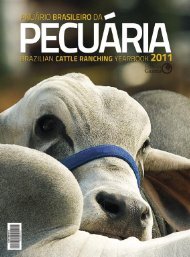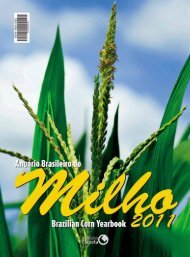tradicionalmenteinovador - Brazil Buyers & Sellers
tradicionalmenteinovador - Brazil Buyers & Sellers
tradicionalmenteinovador - Brazil Buyers & Sellers
You also want an ePaper? Increase the reach of your titles
YUMPU automatically turns print PDFs into web optimized ePapers that Google loves.
vegetable more alluring.<br />
Data gathered by Embrapa Vegetables,<br />
based in Brasília (DF), from<br />
the producers’ side, indicate that carrot<br />
crops expanded 430%, in comparison<br />
to 1980. During that decade<br />
and the next, in the 1990s, there were<br />
considerable increases both in planted<br />
area and productivity rates, due to the<br />
implementation of new technologies.<br />
The production volumes stabilized, but<br />
they have still been slightly and gradually<br />
rising since 1980, leading to the<br />
biggest volume on record, in 2009: 796<br />
thousand tons.<br />
Back then, carrot prices also soared<br />
considerably, from R$ 1,040 to R$ 1,200<br />
a ton, which generated total revenue<br />
of R$ 955.2 million. According to Embrapa,<br />
the crop generates 159 thousand<br />
Jobs throughout the Country.<br />
Analyses released by the Center for<br />
Advanced Studies on Applied Economics,<br />
a division of Luiz de Queiroz College<br />
of Agriculture, linked with the University<br />
of São Paulo (Cepea/Esalq/USP), on<br />
the main production fields, confirm the<br />
continuity of the good yields and area<br />
increases, at least in the summer crop<br />
of the 2010/11 season.<br />
Regions that stand out for their<br />
production volumes are spread<br />
throughout Minas Gerais (São Gotardo,<br />
Santa Juliana and Uberaba), Bahia<br />
(Irecê and João Dourado), Paraná<br />
(Marilândia do Sul, Apucarana and<br />
Califórnia), Rio Grande do Sul (Caxias<br />
do Sul and Antônio Prado) and Goiás<br />
(Cristalina).<br />
In terms of national consumption,<br />
Family Budget Surveys conducted by<br />
the <strong>Brazil</strong>ian Institute of Geography<br />
and Statistics (IBGE), in 2002 and 2008,<br />
point to a decrease in per capita consumption<br />
from 1.75 kilos to 1.55 kilos<br />
a year. This realization is cause for concern<br />
and should prompt campaigns intended<br />
to conquer consumers, a move<br />
that is already underway, consisting in<br />
minimal processing initiatives, whereby<br />
the product is presented in distinct<br />
and more practical packaging, which<br />
is taken as the right course for getting<br />
consumption back on track.<br />
Inor Ag. Assmann<br />
57





